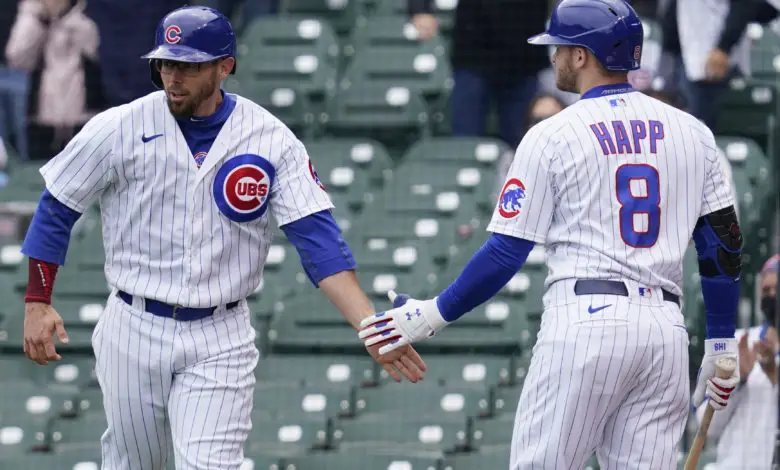
Ugly Confluence of Grounders, Strikeouts Proving Ian Happ’s Struggles Aren’t Just Bad Luck
There’s an age-old trope centered around trying to plug a hole in a dam only to find out another has sprung up elsewhere. Maybe the story ends well and the water is held back, but too many leaks can irreparably compromise the integrity of the dam. Though Ian Happ isn’t yet at the point of being labeled completely broken, all you can say when looking at his performance this season is “Damn.”
After a hitless night in Atlanta that saw him batting in the eight-hole, Happ has but one extra base hit — a homer on April 4 — and is one for his last 19 dating back to April 21 against the Mets. He’s been moved out of the leadoff spot for good reason and had a brief stop at fifth before David Ross thought better of it. This might not be all that troubling if it was your garden-variety slump, but the issue is that this looks like a horse of a different color entirely.
When Happ was sent down to Triple-A to open the 2019 season, it was a matter of patching over holes in his swing that had led to a 36.1% strikeout rate the year before. Though he’d actually been an above-average producer at the plate with a 106 wRC+ and 1.5 fWAR, his spring performance did nothing to indicate he was ready to bounce back.
Not that spring training provides definitive proof one way or the other, mind you, it’s just that a .135 average and 14 strikeouts in 42 at-bats isn’t indicative of positive growth.
So Happ spent most of the season in the minors, first getting over the sting of his demotion and then dedicating himself to changing with the help of minor league hitting coordinator Chris Valaika. Perhaps Valaika, who is now the Cubs’ assistant hitting coach, can rekindle some of that old magic. The process of getting Happ back to good involved a total reworking of his swing that yielded some interesting results.
One of those was that Happ essentially stopped hitting the ball in the air at all as he focused on a shorter “B-hack” meant to generate contact rather than power. As expected, his strikeouts were way down as well. Once he’d honed in on that skill, he was able to get back to a more balanced approach that saw him combine aggressive power early with better contact late.
Sure enough, Happ exploded when he was called back up to Chicago and hit 11 homers in just 156 plate appearances to close out the 2019 season. His .300 ISO was easily the highest mark of his career, his 25% strikeout rate was easily the lowest, and he equaled the previous season’s fWAR total in roughly one-third of the opportunities.
That approach carried into 2020 as Happ posted a career-best .369 wOBA and 132 wRC+ while leading the Cubs with 65 hard-hit balls (47.8%). He was hitting the ball on the ground more than he had in the past, a likely byproduct of that B-hack, but he was also hitting a lot of line drives. What we’re seeing this year, however, is like some sort of bastard mutation of those results.
Through his first 90 plate appearances, Happ’s 50% hard-hit rate is the highest he’s ever produced and it leads the team. Combined with a measly .214 BABIP, it’s enough to make you think the outfielder is merely the unfortunate victim of tough luck. However, his 9.1% barrel rate is the lowest of his career and ranks seventh among Cubs with at least 20 plate appearances this season. Without peaking, can you guess what that means?
Happ’s groundball percentage has skyrocketed to an absurd 58.1%, the highest of his career by nearly 13 points, and both his line drives and fly balls have dropped as a result. That’s because his average launch angle has plummeted to 2.6%, 11th lowest among 163 qualified hitters. So it’s not just a matter of failing to barrel the ball up, it’s that Happ is getting on top of the ball and beating it into the ground way too often.
That might not be so bad if the issue wasn’t being compounded by a 32.2% strikeout rate that spiked recently after creeping up over the first few weeks. Through his first 23 plate appearances, Happ was at 26.1%; his next 21 PA’s were 28.6%; the next 25 were 28%; the last 21 have been 47.6%. For the sake of context, his grounder rate in that most recent sample is an unbelievable 87.5% and he’s produced a -12 wRC+ with a .142 wOBA.
The good news here is that we’re dealing with small enough numbers both of late and in aggregate that things can get turned around in a hurry. What’s really troubling, though, is the confluence of both the best and the worst of Happ’s previous approaches. He’s hitting the ball harder, but he’s hitting it on the ground more. He’s taking more walks, but he’s also taking strike three more often.
If I was to offer a solution as to what might help turn things around, I’d say Happ needs to get more aggressive when it comes to ambushing first-pitch strikes. He’s seeing more of them than ever (63.3%, per FanGraphs) and is only swinging at 29.7% of them. That’s higher than only last year (24.7%), when he saw first-pitch strikes a mere 57.6% of the time, so he’s actually missing out on a few extra strikes.
It appears as though Happ is being too patient and then putting himself into situations in which he’s forced to swing at too many pitcher’s pitches, hence the shift in his batted-ball profile. All the Cubs can really do at this point is work with him and hope the same trends that have emerged alarmingly over the last week or so reverse course just as quickly.
